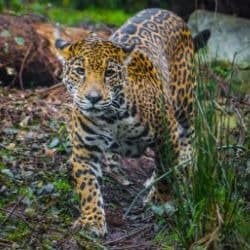Six Facts About Jaguars

The range that jaguars roam through is enormous. They can be found as far South as Argentina and as far North as Mexico. In fact, recently some wandering males were spotted in Arizona. Despite the fact their territory is so expansive, their DNA suggests this big cat is remarkably homogenous throughout the entire range. This fact has only recently come to light over the last few decades. If you are wondering what makes jaguars special, here are 6 facts about jaguars.
The jaguar territory is shrinking
Historically, jaguars could be seen everywhere from the South-West USA and across South America as far as Northern Argentina. Unfortunately, their range is disappearing and half of their range has been eliminated. Their stronghold remains in Brazil where about half the estimated 170,000 wild jaguars roam. Most can be found in the rainforest and the Pantanal.
Jaguars are big
Of all the big cats, the jaguar is the third largest species after tigers and lions and is unquestionably the largest cat in North and South America. Their tails alone can measure up to 80cm long whilst they can grow to a length of as much as 170cm. A male jaguar can weigh 120 kilos almost 19 stone. Their size does vary between regions. For examples, jaguars in Central America are roughly half the size of jaguars in the Pantanal. They need to be big to take on the kind of prey they are willing to including giant caiman.
They are spotty
For the average person it is easy to confuse jaguars with leopards. However, to those with trained eyes, it is possible to tell the difference from their rosettes. The jaguar rosettes have black dots in the middle of some of them, whilst leopards do not. Jaguars also have shorter legs, more rounded and larger heads. Jaguars can also be melanistic which means they seem as if they are black. A melanistic jaguar is sometimes referred to as black panthers.
Jaguars are great swimmers
Many domestic cats prefer to avoid water. Whilst tigers do swim, it is rare to find them in the water. In contrast, jaguars do not avoid waters and typically live by lakes, rivers and wetlands. They are confident swimmers able to cross the Amazon.
Jaguars have a huge roar
Jaguars roar when they seek a mate. Both male and female jaguars engage in the practice. The term for a jaguar roar is a ‘saw’ because it sounds as its name suggests, sawing wood, with the saw moving unidirectionally. When two jaguars meet and greet or reassure each other, they make a distinct sound like a nasally snuffling.
Jaguars will eat almost everything
Jaguars are opportunistic predators. This means they will prey on almost anything they come across. They will hunt the largest animals in South America, the tapir and huge apex predators like caiman. They tend to hunt both at night and day time and will travel up to 10 kilometers when they are on a hunt.



